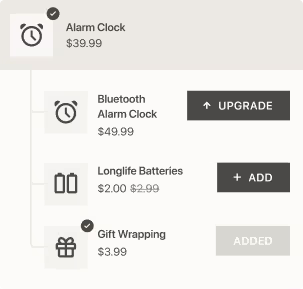Customer retention is a key e-commerce metric that refers to the percentage of customers who make repeat purchases. It’s vital to track and improve customer retention because it costs significantly less to sell to an existing customer than it does to acquire a new one and it helps build a loyal customer base that will spread the word about your brand.

How to measure customer retention?
To calculate your retention rate, you should take the number of customers you have at the end of the analyzed period, subtract the number of new customers acquired during that period, and divide the result by the number of customers you had at the beginning of that period.
For instance, a store had 100 customers by the beginning of January, got 20 new ones, and lost 30 in the course of the month. Its customer retention rate this month would be (90-20) / 100 = 0,7, or 70%.
💡 In Shopify, you don’t need to measure your customer retention manually. In the Analytics section, you’ll see the Returning customer rate graph that will calculate the rate for you. You can see its value for any given period, be it a month, a year, or a chosen time range, as well as compare it to another period.

You should strive for your customer retention rate to get as close to 100% as possible. The higher this number grows, the healthier is your business and its relationships with shoppers. Here’s why.
The importance of customer retention
The metric of customer retention defines a store’s longevity and sustainability in its development for the following reasons:
- The cost of customer retention is much lower than that of acquisition. As many as 82% of companies agree with this statement, and the chances of selling to an existing customer reach up to 70% compared to 5-20% with a new prospect.
❗ While measuring customer retention and improving it should be among your top priorities, don’t focus on it at the earliest stages of your business. As you can see from Shopify’s graph below, you should increase your attention to retention compared to acquisition only when you get 10+ orders per day.

- Focusing on retention helps create a community of loyal customers. The more people are returning to your store and continuously receiving positive shopping experiences, the more honest brand ambassadors you get. Your repeat customers are likely to share some content with your products and send links to friends, which can increase the pool of new buyers for you. In fact, 60% of consumers talk about the brands they trust with friends and family.
💡 Do you know how to distinguish your star customers? Check out our app Loyal which will do this automatically. It uses RFM analysis to provide you with 6 customer segments, including loyal ones, those that can become loyal, and those that are on the verge of losing loyalty. Try it for 30 days for free.
- High customer retention means increased AOV and CLTV. Emotional connection to a brand increases a customer’s lifetime value by 306%, and loyal shoppers tend to spend more and buy more expensive items.

- Consistently high customer retention translates into healthy profit growth. In the long run, existing customers should account for more than half of your sales as they are your steady source of profits. It’s been estimated that even a slight, 5% increase in customer retention can bring up to 95% more profits.

While it’s clear that any e-commerce business needs to engage its existing buyers, what customer retention tactics can you use? Let’s discover what you can do to improve customer retention and loyalty.
8 strategies to improve customer retention
We’ll discuss some of the things that successful brands have covered to consistently increase their retention rates.
1. Design a loyalty program that provides value to your customers
A loyalty program is an inexpensive way to boost retention and sales. There are numerous approaches to loyalty programs. Shoppers can accumulate points for each purchase—or for other actions like leaving a review, sharing a post on social media, or registering an account—and then exchange them for real products or a discount.
You can also provide participants with exclusive deals and premium services. According to Shopify’s data, offering more premium products and services tops the list of customer acquisition and retention strategies merchants are going to use in 2023:

Another idea is to create several loyalty tiers where the more a person purchases the higher is their discount. Or, you can limit the effort to a referral program where a person gets a fixed amount off their next order for each new customer they bring.
💡 Some affiliate Shopify apps will help you create a customer referral program.
2. Personalize your offers
Even though increasingly more consumers are worried about protecting their online identity, they still appreciate personalized communication that leverages the data about them.

What can you do to maintain personalization?
- Allow users to register an account on your site and add items to a wishlist. Based on account data, you’ll be able to create relevant upsell and cross-sell offers, surprise a person with a gift on their birthday, etc.
- Craft a product quiz to learn about each customer’s preferences. Quizzes are a great tool to boost conversions as they are fun and help find the right items.
- Tailor email campaigns to each individual customer group. Don’t send the same email to your customer base but customize different templates to different segments based on their purchasing behavior and level of engagement.
- Evoke sentiment by using names. When you know your customer’s name, use it in your emails and SMSs. For some niches, it makes sense to use other personal data—for example, a pet’s name—to make your messages look cuter.
Pet owners just can’t miss the email that has their pet’s name in the subject line:

3. Provide a simple checkout process
A seamless checkout process can help reduce shopping cart abandonment and encourage repeat purchases. Consider offering multiple payment options and make sure the checkout process is optimized for mobile devices.
Learn more details from our guide to checkout optimization. And if you’re wondering what can, and can’t, be tailored to your brand in Shopify at this stage of purchase, read our post about Shopify checkout customization.
4. Build trust
Trust is a key factor in customer retention, as people return to your store not only because they are satisfied with products and services but also because they feel safe about their purchases and usage of their data.
You should make your privacy policy distinctly visible on your site and display supported payment method badges. As you can see in the graphs below, the majority of shoppers prefer companies that are transparent about data usage; plus, they are more likely to spend more with these trusted companies even when competitors offer lower prices.

Also, create a clear page about your return policy to give customers peace of mind. Over 80% of consumers are more likely to buy from companies that make returns easy, and 95% claim that a positive return experience will make them return to a store.
Don’t forget about the shipping details and explain what locations are covered, what are the rates, and what timeframes are offered. People often expect next-day or even same-day deliveries, and they should feel confident that their order will arrive when they expect it.
5. Create a feedback loop (and don’t forget to close it)
Encourage your customers to leave product reviews by sending follow-up emails after their purchase and give out free gifts or discounts in exchange for a review. Create a sequence of emails that are centered around gathering feedback after an order.
Don’t limit yourself to just one email after the order is received but remind a customer about an opportunity to share their thoughts. Make sure to close the loop—respond to the feedback and thank for it (even if you don’t offer something in return, a thank-you message can do marvels in building the bond with a customer). If there are complaints in a review, address them in your response.
💡 You can experiment with the ways your reviews are displayed on the website. Use Shopify product review apps to create visually appealing blocks with customer feedback on your product pages and add featured testimonials to the homepage.
Satisfaction surveys are another opportunity to get feedback on your products, fulfillment, and brand interactions in general. Don’t send them to one-time customers and don’t send them too often—maintain a calendar adjusted to customers’ purchasing frequency and other factors.

6. Offer fast and helpful customer service
Make sure that your customers have a positive experience every time they interact with your business. Educate support reps so that they know the ins and outs of your products, payment methods, delivery, return policies, etc. Automate the process if you get too many inquiries so that you have a manageable ticket system to provide timely responses to everyone.
7. Stay in touch (but don’t get clingy)
Keep your customers informed about new products, sales, or other updates through newsletters, social media, or other channels. You can set up a communication calendar based on the customer segments you have so that you stay relevant to those who are engaging with you regularly and re-establish the relationship with those who haven’t interacted with your store for some time.
Don’t spam shoppers with news and offers though and give them a clear option to opt out of your marketing emails.
8. Create a sense of community
The power of social media not only opens ways for immediate purchases of social commerce and easy collaboration with influencers but also lets you form a community around your brand.
By maintaining a presence on social platforms, you can get closer to your existing customers and encourage prospective ones to buy from you. For instance, Twitter helps break the boundaries between companies and consumers—but to do so, you need to really engage with users, not just post your updates but respond to tweets. This way, you’ll be creating an image of the brand that cares about its customers.
Here’s an example of how a pet store interacts with a satisfied customer on Twitter:

Social media responses are also crucial when you get an unflattering review or when people are confused about something. Here’s how a nutrition brand responds to an unsatisfied customer:

Simple thank-you messages and encouragements, as well as informative replies about the issues your customers face, can build trust, boosting your customer loyalty and retention.
Employ customer retention strategies that speak to your brand
If you haven’t already, add customer retention management to your agenda and analyze the retention rate across different time periods. If you’re not happy with its values, think about what can block customers from returning to your store: monitor if competitors are not offering better deals, re-evaluate your collection and product pages, tap into complaints (if any), check your emails’ deliverability, etc.
If your customer retention rate is rather high, it doesn’t mean you shouldn’t worry about it anymore. Strive to consistently give your customers exceptional experiences and have offers up your sleeve that will interest them at different times.

















